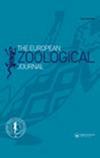Diet of feral cats during the Scopoli’s shearwater breeding season on Linosa Island, Mediterranean Sea
引用次数: 11
Abstract
Abstract Feral cats (Felis catus) are considered to be one of main successful invasive species of island ecosystems. The introduced cats often negatively affect seabird populations due to the lack of anti-predatory strategies resulting from the absence of mammalian terrestrial predators during their evolutionary development. Linosa Island hosts the second largest colony of Scopoli’s shearwater (Calonectris diomedea) of the species. In this study, we estimated the number of cats on Linosa Island and we evaluated their diet using a non-invasive method: scat analysis. Scat collection took place in the northern part of the island in the Scopoli’s shearwater colony, where a feral cat colony lives permanently. We analysed a total of 188 cat scats, collected during the different stages of the shearwater breeding period. Introduced mammals were the most frequent preys: wild rabbits and black rats occurred in scats with the same frequency (28.72%). Birds were the second most frequent prey category found, primarily represented by the seabird Scopoli’s shearwater (16.49%). The cats’ diet varied seasonally in relation to prey availability and accessibility: shearwaters were mainly preyed upon during spring when they exhibited the greatest vocal activity and spent the most time out of their nests. Regarding the biomass, mammals were the dominant prey, and wild rabbits were the most consumed species. However, Scopoli’s shearwater represented approximately one-third of the total biomass consumed. Consequently, the management of feral cats living in proximity of the seabird colony is strongly required, and the increase of “trap-neuter-release” (TNR) programmes is necessary in order to avoid uncontrolled gains in the cat population on Linosa Island. Since the cats have a crucial role in controlling the rat population (the main threat for shearwaters), before planning management strategies, the complex inter-relationship that exists between species must be taken into account.地中海利诺萨岛上野猫在海鸥繁殖季节的饮食
摘要野猫(Felis catus)被认为是岛屿生态系统的主要成功入侵物种之一。由于在进化发展过程中缺乏陆生哺乳动物捕食者,因此缺乏反掠食性策略,因此引入的猫往往对海鸟种群产生负面影响。利诺萨岛拥有该物种的第二大海鸥群(Calonectris diomedea)。在这项研究中,我们估计了Linosa岛上猫的数量,并使用一种非侵入性的方法:粪便分析来评估它们的饮食。粪便收集工作在岛北部的Scopoli 's shearwater栖息地进行,那里有一群野猫永久生活在那里。我们分析了在海鸥繁殖期不同阶段收集的188份猫粪。以引进哺乳动物为最常见的捕食对象,野兔和黑鼠的发生频率相同(28.72%)。鸟类是第二常见的猎物类别,以海鸟为代表(16.49%)。猫的饮食随猎物的可获得性和可接近性而变化:海鸥主要在春季被捕食,因为它们表现出最大的声音活动,并且在巢穴外呆的时间最长。在生物量上,哺乳动物是主要的猎物,野兔是消耗最多的物种。然而,Scopoli的shearwater约占总生物量消耗的三分之一。因此,强烈需要对生活在海鸟群附近的野猫进行管理,并且有必要增加“陷阱-绝育-释放”(TNR)计划,以避免Linosa岛上猫数量的不受控制的增加。由于猫在控制老鼠数量(对海鸥的主要威胁)方面起着至关重要的作用,在制定管理策略之前,必须考虑到物种之间存在的复杂相互关系。
本文章由计算机程序翻译,如有差异,请以英文原文为准。
求助全文
约1分钟内获得全文
求助全文

 求助内容:
求助内容: 应助结果提醒方式:
应助结果提醒方式:


